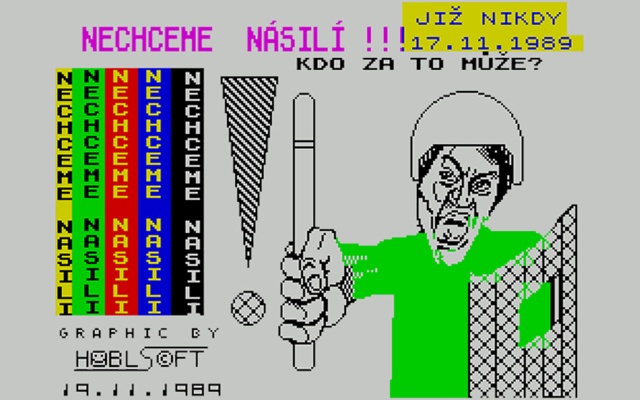The history of hacking in the post-Soviet space started well before the proliferation of the internet and modern PCs. In the 1980s, local computer fans had to use smuggled hardware and pirated software; there was no authorized service and no software market. In part, computer hobbyists became hackers out of necessity, to repair their hardware and build their software from shards of Western code. They also enjoyed it, creating vibrant do-it-yourself communities, whose open-minded, and often subversive, spirit contrasted with the dull reality of late Socialism.
This essay, based on the research for my book Gaming the Iron Curtain, will offer a peek into the Czechoslovak hobby computing scene by following the story of a young Czechoslovak computer enthusiast, with detours into the work of his peers and idols.
8-bit objects of desire
When Martin Malý went to elementary school, his teacher poked fun at his untidy handwriting. “Martin here thinks that one day, the computer will be typing everything for him!” she exclaimed. Martin, born in 1973, was a geeky kid from a village in the Czech heartland, who had long been interested in programming. He started writing code on a paper mock-up computer, published as an educational tool by a local youth magazine; later, he got some practice on his classmate’s programmable calculator. It was mid-1980s Czechoslovakia, and home computers had already entered the public imagination – but they had not entered retail stores. One day, Martin went to a trade show that presented the achievements of the centrally planned economy, and first saw the Tesla PMD 85, a scrappy 8-bit machine that pretended to be a miracle of socialist engineering. But so few of these machines were manufactured that they never made it into shops. Instead, they were sold directly to schools and youth clubs. At the same time, foreign-made computers were rarely officially imported because of export embargoes on the Western side and the lack of Western currency on the Czechoslovak side.
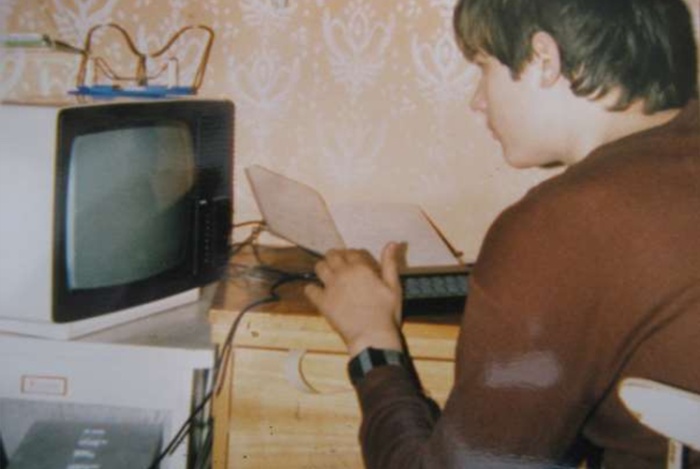
Martin Malý pisze na ZX Spectrum u siebie w domu. Zdjęcie: archiwum prywatne Martina Malégo.
In 1985, Martin joined a computer club in the nearby town of Nymburk, which did own a few PMD 85s. It was one of the many clubs dotting the country, where people could gather and exchange software, games, and programming know-how. As all hobby groups in the country had to have official backing, many affiliated themselves with youth or paramilitary organizations or with individual schools or factories. By that time, Czechoslovakia had become a do-it-yourself paradise with a vast network of hobby groups of all kinds. There were few career opportunities for anyone except party apparatchiks, and masses of people therefore half-heartedly pounded away at their “real” jobs only to regularly retreat to private lives or hobby projects – building cabins in the countryside, mushroom hunting, tinkering in their sheds, soldering electronics, or programming.
Computer clubs were officially overseen by state authorities, but their day-to-day operations were devoid of ideological scrutiny. As the leader of Martin’s club put it: “When the lady in charge is around, you must call me ‘comrade,’ but otherwise, just call me ‘boss.’” Or as the anthropologist Alexei Yurchak has explained it in more sophisticated language, computer clubs were vnye spaces. The Russian word vnye can mean both inside and outside, and such was the position of these hobby clubs in relation to state power. Nominally, they were at the heart of the socialist project, fulfilling the mission of scientific and technological progress, and contributing to the socialist economy. This proclaimed mission has, however, granted them considerable autonomy, and they soon became some of the most open-minded spaces in the country. Computer games, likewise, became arguably the least regulated medium in the country – simply because the authorities did not realize that they were a medium.
The Nymburk computer club was where Martin met his kindred spirits. He wrote some code on the PMD 85, but soon got introduced to the British Sinclair ZX Spectrum, a tiny machine that looked much cooler and sleeker than the bulky Czechoslovak ones. By then, the Spectrum had become the number one platform in the country thanks to the enthusiasts who imported – or, thanks to its small size, smuggled – it from the West. Soon thereafter, Martin started begging his parents to buy him a Spectrum. In late 1986, they conceded, but obtaining the machine was no small feat. Going abroad was next to impossible, so Martin’s mom contacted her old friend who had emigrated to West Germany after the 1968 Soviet invasion. The friend got hold of a Spectrum and brought it to Czechoslovakia when visiting her family. By Christmas 1986, the Spectrum had arrived at the Malý household, and Martin joined thousands of other home computer owners who had gone through similar ordeals.
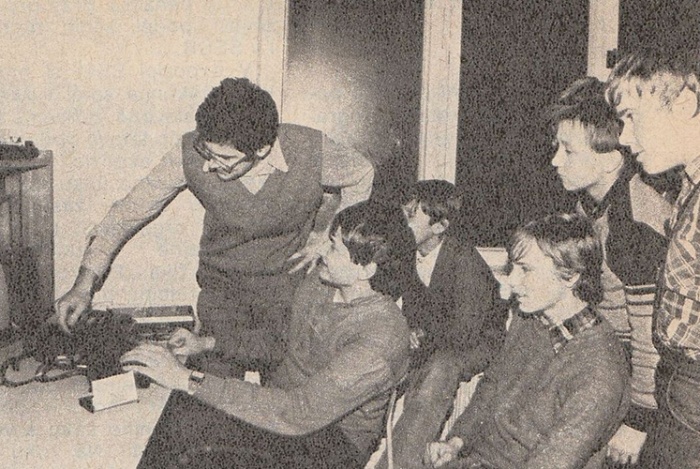
Klub komputerowy w Pradze, zdjęcie z pisma „Kronika”, 1986. Po lewej František Fuka, wpływowy autor czechosłowackich tekstowych gier przygodowych. Autor zdjęcia nieznany.
Scrollers and Easter eggs
Martin was initiated by an older friend who copied a dozen – mostly British – games onto a blank cassette tape. Playing games was fun, and there were plenty to be had. The so-called “exchange network” of software was vast, efficient, and free of any legal or moral constraints. Most people believed that it was legal, and even beneficial, to share games with your peers. And so, by the end of his Spectrum career, Martin had amassed 28 tapes, each holding around a dozen to twenty titles. Writing one’s own games promised even more fun. As he put it himself, they provided a space where he could tell his stories and let his creativity run wild.
Martin already had some knowledge of the BASIC programming language from magazines and club instructors. But he soon realized that to do decent music, animation, or any kind of impressive tricks, one had to learn the secrets of machine code. Not a programming language per se, machine code consists of the commands given directly to the computer’s CPU. It was not designed to be understood by regular programmers, let alone kids. There were few experienced instructors of machine code and even fewer available textbooks. Club members – mostly boys and young men with plenty of free time – thus learned informally, from older peers and by dissecting existing games. An important stepping stone was a practice called “poking” – altering the code of an existing game to gain gameplay advantage, such as infinite lives. More experienced programmers could even try their hand at “cracking” – removing copy protection from original copies of imported games. Socialist youth clubs thus became de facto hacker incubators, where teenagers learned to break into Western code, and repurpose it for their own projects.
By the time Martin had started making his own games, he had examples to follow. František Fuka, five years older than Martin and based in Prague, was the brightest star on the scene. In 1985, Fuka wrote Indiana Jones and the Temple of Doom, a Czech-language text adventure game starring the iconic Western hero. By doing so, he contributed to the massive popularity of text adventures, a genre of games controlled by typed-in commands that told stories with text descriptions. Besides writing text adventures, Fuka wrote action games, composed game music, and was an active “cracker,” all under the Western-sounding label Fuxoft. Together with his two friends from a Prague computer club, Tomáš Rylek (or T.R.C.) and Miroslav Fídler (or Cybexlab Software), he formed a collective called The Golden Triangle. In the Slovak city of Bratislava, a prolific group of high schoolers who called themselves Sybilasoft started releasing popular text adventures in 1987. One of them, Fuksoft, featured a cast of their friends and schoolmates, as well as characters borrowed from the games by František Fuka. It even featured Fuka himself as a victim whom the main character had to rescue. Interestingly, the members of the two collectives had never met each other in person, and only knew each other through their games. Around this time, it became quite common to insert references, shout-outs, and greetings to other members of the community, some of them quite explicit and some of them hidden away. Computer games became a fully-fledged means of communication within a subculture of young geeks, like 8-bit chain letters or, perhaps, social media of the early digital era.
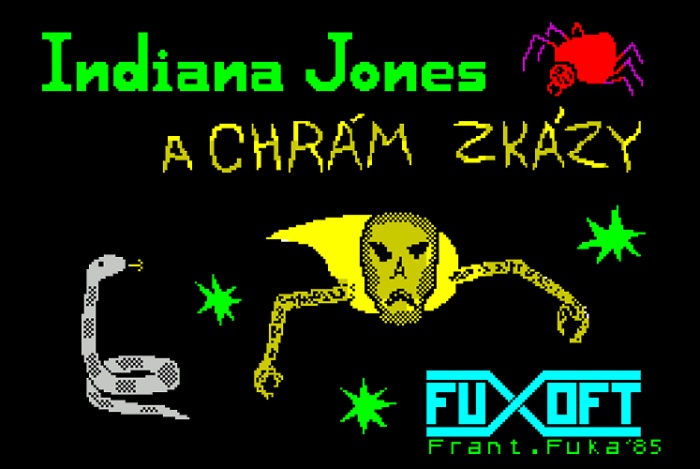
Ekran startowy gry Indiana Jones i Świątynia Zagłady (Fuxoft, 1985).
The most common type of explicit message was a scroller, a line of text scrolling from right to left, usually on the bottom of the game’s menu screen. (Scrollers were also a cornerstone of crack intros made by Western cracking groups, but this trend did not catch on in Czechoslovakia.) In the scroller of Galactic Gunners, an impressive 1987 shooter game by Cybexlab Software, we can, for example, read the author’s real name (Miroslav Fídler), his address (important for swapping software and maintaining the exchange network), and a request for collaborators on future projects. Sometimes, a scroller could even overshadow the game itself, as in the case of Piškworks, a solid adaptation of the local variant of tic-tac-toe written by Patrik Rak, a friend of the Golden Triangle group. His scroller contained about four pages of text, including greetings to sixteen other programmers, complaints about his upcoming graduation exam, and a message to an unknown “scoundrel” who had borrowed one of his cassettes and did not return it.
Messages could also be hidden. Most of these would classify as Easter eggs, defined by the game historian Laine Nooney as “digital objects, messages, or interactions built into computer programs by their designers” that are “intended as a surprise to be found by the user, but they are not required in order to use the program.” A classic example can be found in Fídler’s flip-screen shooter Planet of Shades from 1987. A hard-to-reach corner of the game’s map hides a goblin-like head set on a pedestal saying “Dočekal,” referring to a computer club manager whom the Golden Triangle liked to make fun of. Another of Fídler’s games, a shoot-em-up called Star Fox (also 1987), featured tough “boss fights” with his friends, including “Evil Devil Fuka” who drops bombs that need to be extinguished by a bucket of water. This fight, by the way, replicates the gameplay of Fuka’s own 1986 game Kaboom!, in turn a conversion of a 1981 US game of the same name for the Atari 2600. Although these boss fights are not Easter eggs in the narrow sense, as one needs to pass them to continue playing, they are indeed surprising. Moreover, including a whole new game inside the main game was a testament to Fídler’s formidable skills.
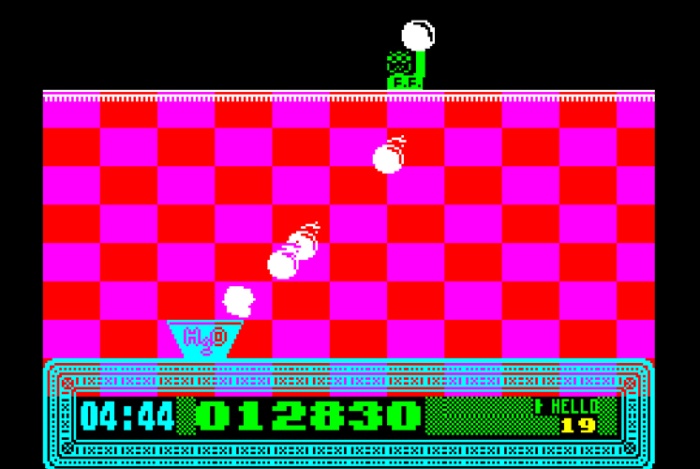
Pojedynek ze „Złym Diabłem Fuką” w grze Star Fox (Cybexlab Software, 1987).
This game is revenge
Through the unassuming door of a youth computer club, Martin Malý entered a subculture where your friend could be a boss monster, where games were as reference-heavy as hip-hop lyrics, and where young masters of machine code tried to outdo each other with clever tricks. It was an interconnected community concerned with friendly competition and communication rather than profits. The exchange network was not only a source of Western games, but also a potential audience for one’s work. Martin was fascinated by the idea that “somebody is using it, playing it, that somebody knows me and notices me.”
Following his idols from the Golden Triangle and Sybilasoft – whom he had not met in person – he came up with the moniker Demon Software (sometimes extended all the way to Demon Software Studio Ltd.). He was neither the first nor the most proficient creator, but he was prolific. In 1988 alone, he released at least five titles, Mr. Hyde’s Murder, Advisor (Poradce), Nick Carter, Katanga, and Demon in Danger. Most of them reused characters, graphics, sounds, or other routines from existing games. While this was not uncommon on the Czechoslovak scene, Martin defended this practice in one of his intros by noting that “according to Edgar Allan Poe, the art of creation lies in a combination of things that are already known.” All his games were text adventures, influenced mainly by Ed McBain and Western crime fiction in general. There was one important exception. Possibly inspired by Sybilasoft’s Fuksoft, Demon in Danger took place in his family’s home in the village of Chleby. Playing as one of Martin’s classmates, the goal of the game was to defuse a bomb planted in the apartment before Martin comes home from school. Although the game does not actually show graphics of individual rooms, it makes up for this by detailed, almost superfluous textual descriptions. We can learn, for example, the brand and the price of the rug in front of the apartment door. We can even visit the “Demon’s office” – or, more precisely, Martin’s bedroom – and check out his hard-earned ZX Spectrum machine. The address of the apartment was included in all his games, and one evening, he even got an unannounced visitor who had played Martin’s games and wanted to meet him.
Besides the “public” part of his games, Martin also planted Easter eggs into the code. Breaking into programs was a favorite pastime of the scene, and Martin anticipated it, leaving messages like: “Here comes another one who thinks they’ll figure out how to make text adventures. Really, you won’t find anything here!” Another, more confrontational, read: “So you’ve decoded this, although I spent a lot of time encrypting it. Be forever damned!” The secret message in Katanga revealed that the game was “written as an original form of revenge” and that individual in-game characters corresponded to the classmates that Martin was cross with. We can see that games were not just an entertainment medium, but that they could be very personal. I have previously called them “coding acts,” suggesting that we should investigate them as situated, personal actions, rather than just pieces of software.
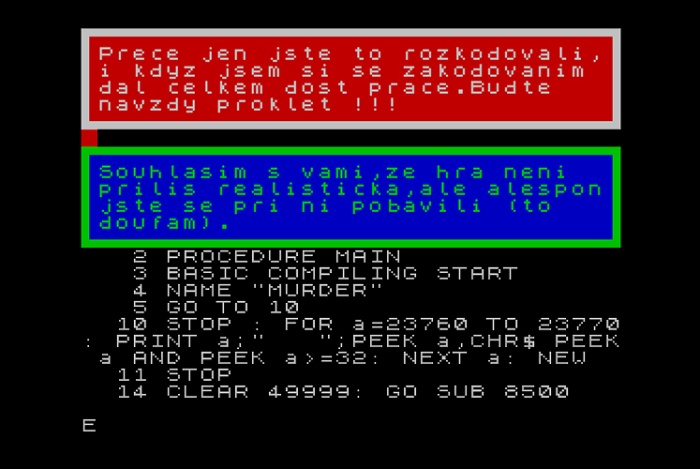
Ukryty komunikat w grze Morderstwo pana Hyde’a (Demon Software, 1988), „przeklinający” każdego, kto włamał się do kodu źródłowego.
After a string of games from 1988, there was a pause in Martin’s output, coinciding with what he jokingly calls his “dark period” of Summer 1989. Unlike most other computer club geeks who were “good boys from good families,” Martin had a rebel in him. As the Soviet bloc was on the brink of falling apart and youth culture was getting more and more powerful and subversive, he left home to hang out with punks and dissidents in Prague. He was sleeping in a friend’s basement, where they discussed the latest rumors of fights between punk rockers and skinheads. After about two weeks, the group of young wannabe punks was stopped by the police and accused of plotting anti-Communist schemes. Martin – underage and reported missing – was immediately sent back to Chleby. Inspired by his Prague experience, he wrote Fuck Off…!, a text adventure that, to quote the intro, “takes place in an American city but could just as well take place here.” The player investigates the murder of a young punk, and although the initial clues suggest that he was killed by a skinhead, the culprit turns out to be the abusive father of the punk’s girlfriend – suggesting that the real enemies are the intolerant members of the older generation. Soon thereafter, Martin would even change his label from Demon Software to Anarchysoft.
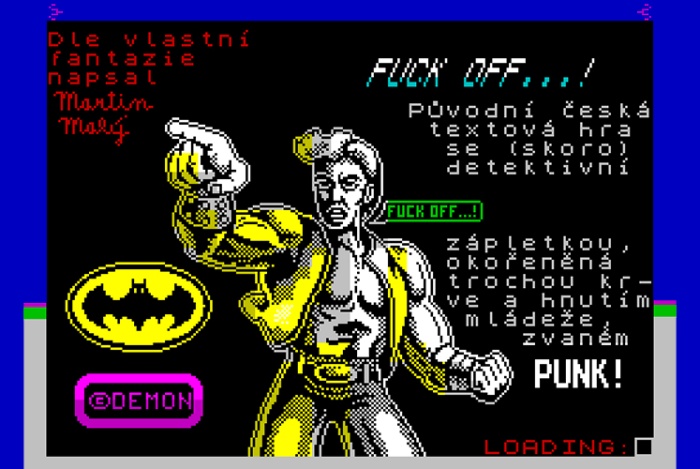
Ekran powitalny gry Fuck Off…! (Demon Software, 1989). Grafika zapożyczona została z gry Renegade (Imagine Software, 1987).
Indiana Jones joins the revolution
While Martin was using his programming skills to celebrate youthful revolt, there were others who wrote games that explicitly subverted the Communist regime and its ideology. Sybilasoft’s Shaktokhin (Šatochin) told the story of a brave Soviet soldier (titular Major Shatokhin) sent on a mission to defeat John Rambo. Although Shatokhin is nominally the hero, he gets killed by Rambo in a number of comical, humiliating ways. Moreover, the game contained brilliant Easter eggs. To the lucky few users who owned a printer for their Spectrum, the game would print additional messages on paper, creating a full-on multimodal experience. Most of them were just scolding the player for their failures and reminding them that “Don’t think you’re a boss just because you have a printer.” As printers were very rare at the time, it is likely that most users would read these messages by breaking into the code. One of the messages contained a key to a whole other part of the game. By redefining keys to K, G, B, one starts a secret (even more humiliating) mini-game taking place in a retirement home for war heroes.
Miroslav Fídler of the Golden Triangle wrote a satirical game called R.E.C.O.N.S.T.R.U.C.T.I.O.N. (P.R.E.S.T.A.V.B.A.), whose goal was to blow up a statue of Lenin, a symbol of the oppressive regime (and along the way, burn a copy of Marx’s Capital). Fídler found this piece too subversive to be launched under his well-known Cybexlab brand, and instead released it under the joke pseudonym ÚV Software (Central Committee Software). Similar to Martin Malý’s titles, it includes an ironic message for nosy hackers. When trying to view the source code, you are told “Stop right there! Such cheating does not befit the morals of a socialist citizen.”
Further anonymously released games even explicitly covered anti-regime demonstrations, which were increasingly attended by students. A satirical game entitled The Adventures of Indiana Jones on Wenceslas Square in Prague on January 16, 1989 takes place during a week-long series of protests brutally suppressed by the authorities. Not written but certainly inspired by the works of František Fuka, it drops Indy in the middle of the riot, and has him avoid and (brutally) defeat the Communist police in order to escape to the US. Another game – called simply November 17, 1989 (17. 11. 1989) – chronicled that day’s protest, which led to the collapse of the oppressive regime. The goal of the game was to shoot a video recording of police brutality and send it to Western journalists. It was relatively easy to finish, and the authors left a note in the code saying: “We think that the game can be finished without cheating, but if you want, help yourselves.”
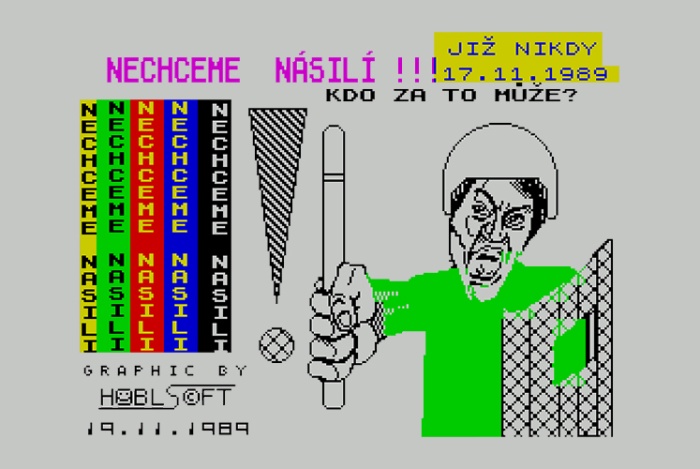
Ekran powitalny gry 17.11.1989 (Doublesoft i Hoblsoft, 1989). Twarz zomowca zapożyczona została z gry The Way of the Exploding Fist [Droga eksplodującej pięści] (Beam Software, 1985).
From shout-outs and hidden greetings, games have thus evolved to carry explicit messages with an activist stance. They were still a niche medium and they hardly contributed to the collapse of the Soviet bloc. But efforts like this placed Czechoslovak teenagers and young amateurs among the first who realized the activist potential of computer games.
Epilogue
As private enterprise and civic life resumed in the early 1990s, the underground subculture of 1980s Czechoslovak gaming went overground. Some of it moved into the early BBS and internet culture, but much of its talent was soon co-opted by the growing domestic IT industries. Some of their biggest successes still maintain a link with the tinkering spirit of the 1980s computer club culture. Three famous antivirus suites, ESET, Avast, and AVG, whose combined worldwide market share was about 37% in 2017, are produced in former Czechoslovakia. Their histories date back to the late 1980s and early 1990s, when Czechoslovak PCs were exposed to computer viruses due to the rampant use of pirated software.
Martin Malý produced one more game as Anarchysoft but gradually moved to other pastimes like “girls and going to pubs.” When he decided to return around 1990–1991, he found out that the scene had changed. It was much more professional, aiming to deliver polished entertainment to paying customers – and he no longer had the chops to compete. After a couple of years of college, he dropped out and worked as a software developer. In 2003, he started a blogging platform called Bloguje.cz, which became extremely popular throughout the country, and generated an open-minded subculture somewhat similar to the 1980s gaming community. The platform’s success owed in part to bloggers like Ostravak, a self-styled loser from the Silesian city of Ostrava chronicling his everyday struggles. These days, Malý works in the news media and occasionally writes op-eds. Interestingly, his early hero František Fuka had also left game development to become a film journalist and translator. What Martin Malý’s story shows us is that coders are often also communicators and that games and other pieces of software can deliver all kinds of messages, including subversive ones. In the end, Martin’s teacher’s joke prediction was somewhat right. He did not really have computer type for him, but he first let other people type in commands into his text adventures, and later had people type his stories on the platform he created.
BIO
Jaroslav Švelch is assistant professor of media studies at Charles University, Prague. He has published work on the history and theory of computer games, on humor in games and social media, and on the Grammar Nazi phenomenon. His latest work is the recent monograph Gaming the Iron Curtain: How Teenagers and Amateurs in Communist Czechoslovakia Claimed the Medium of Computer Games (MIT Press, 2018), in which he traces the hidden histories of home computing in the former Soviet bloc. In 2007–2008, he was a visiting researcher at MIT’s Comparative Media Studies department; in 2017–2019, he was a postdoctoral fellow at the University of Bergen, Norway, working on a project about the history, theory, and reception of monsters in games, which will hopefully result in another book. He lives in Prague with his wife and a dog, and makes music with the alternative rock band Rest In Haste.
* Cover photo:



